Logistics and Supply Chain Management Analysis Report
VerifiedAdded on 2020/04/29
|15
|3500
|123
Report
AI Summary
This report examines key aspects of logistics and supply chain management, focusing on inventory's importance, particularly for a manufacturing company like Wheeled Coach. It addresses excess inventory issues, discusses the role of Enterprise Resource Planning (ERP) systems as an extension of Material Requirements Planning (MRP), and highlights the differences between manufacturing and service industry supply chains. The report analyzes the impact of inventory on revenue and profit, the disadvantages of excess inventory, and methods to minimize it. Furthermore, it explores the functionality of ERP systems, their advantages, and their role in coordinating business operations. Finally, the report contrasts the supply chains of manufacturing and service industries, emphasizing differences in product tangibility, capital investments, and optimization strategies. The role of doctors and nurses in supply chain management is also discussed, along with the process of introducing new products into the supply chain, providing a comprehensive overview of these critical business processes.
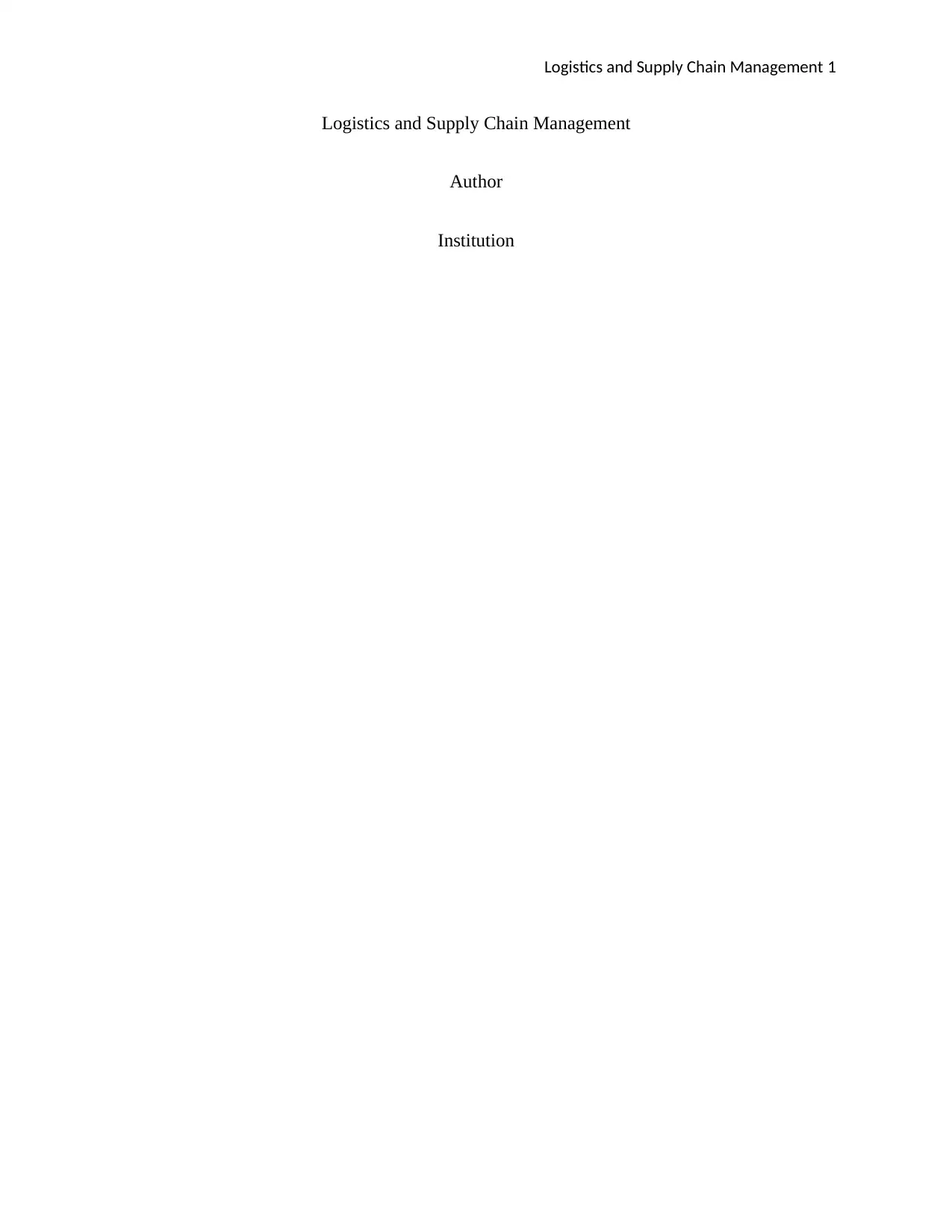
Logistics and Supply Chain Management 1
Logistics and Supply Chain Management
Author
Institution
Logistics and Supply Chain Management
Author
Institution
Paraphrase This Document
Need a fresh take? Get an instant paraphrase of this document with our AI Paraphraser
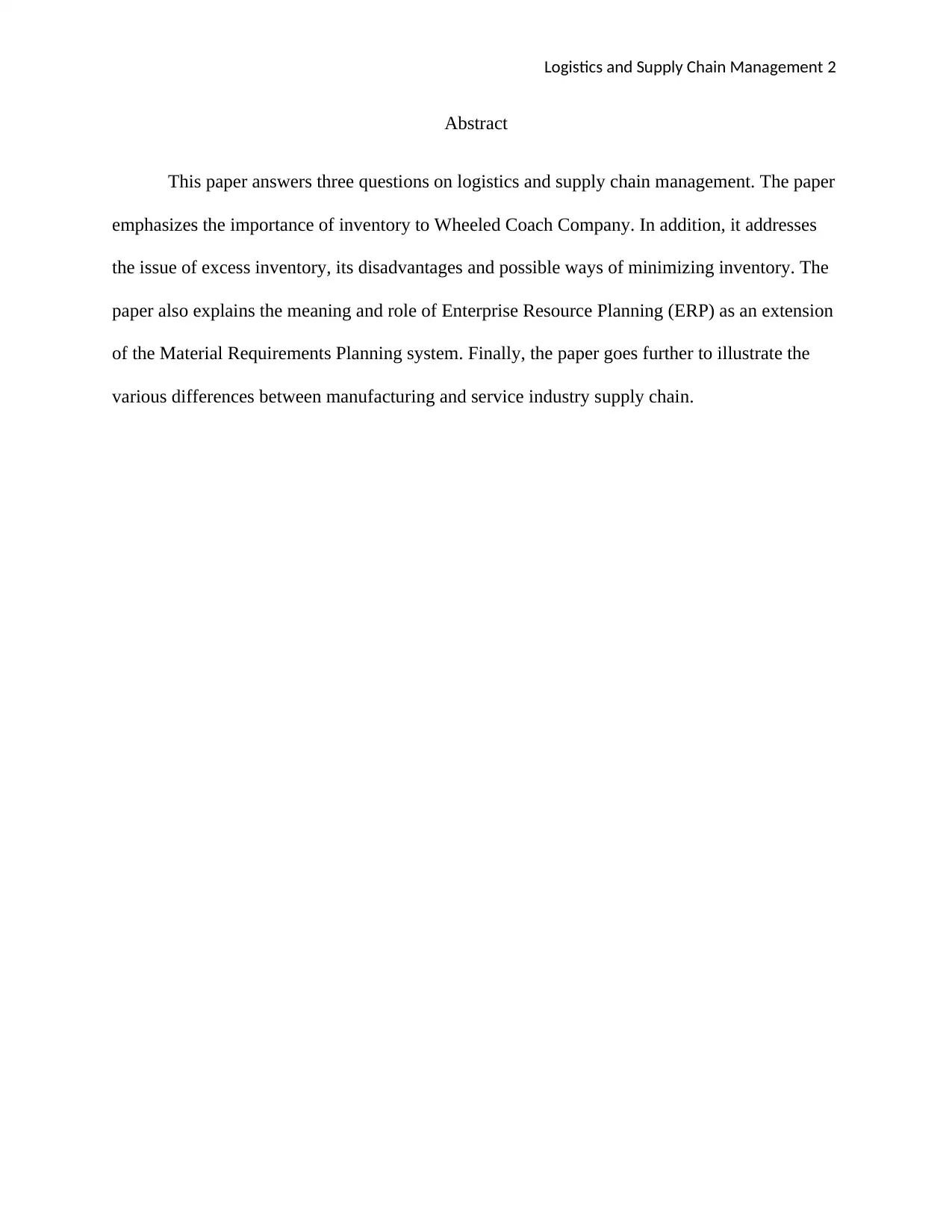
Logistics and Supply Chain Management 2
Abstract
This paper answers three questions on logistics and supply chain management. The paper
emphasizes the importance of inventory to Wheeled Coach Company. In addition, it addresses
the issue of excess inventory, its disadvantages and possible ways of minimizing inventory. The
paper also explains the meaning and role of Enterprise Resource Planning (ERP) as an extension
of the Material Requirements Planning system. Finally, the paper goes further to illustrate the
various differences between manufacturing and service industry supply chain.
Abstract
This paper answers three questions on logistics and supply chain management. The paper
emphasizes the importance of inventory to Wheeled Coach Company. In addition, it addresses
the issue of excess inventory, its disadvantages and possible ways of minimizing inventory. The
paper also explains the meaning and role of Enterprise Resource Planning (ERP) as an extension
of the Material Requirements Planning system. Finally, the paper goes further to illustrate the
various differences between manufacturing and service industry supply chain.
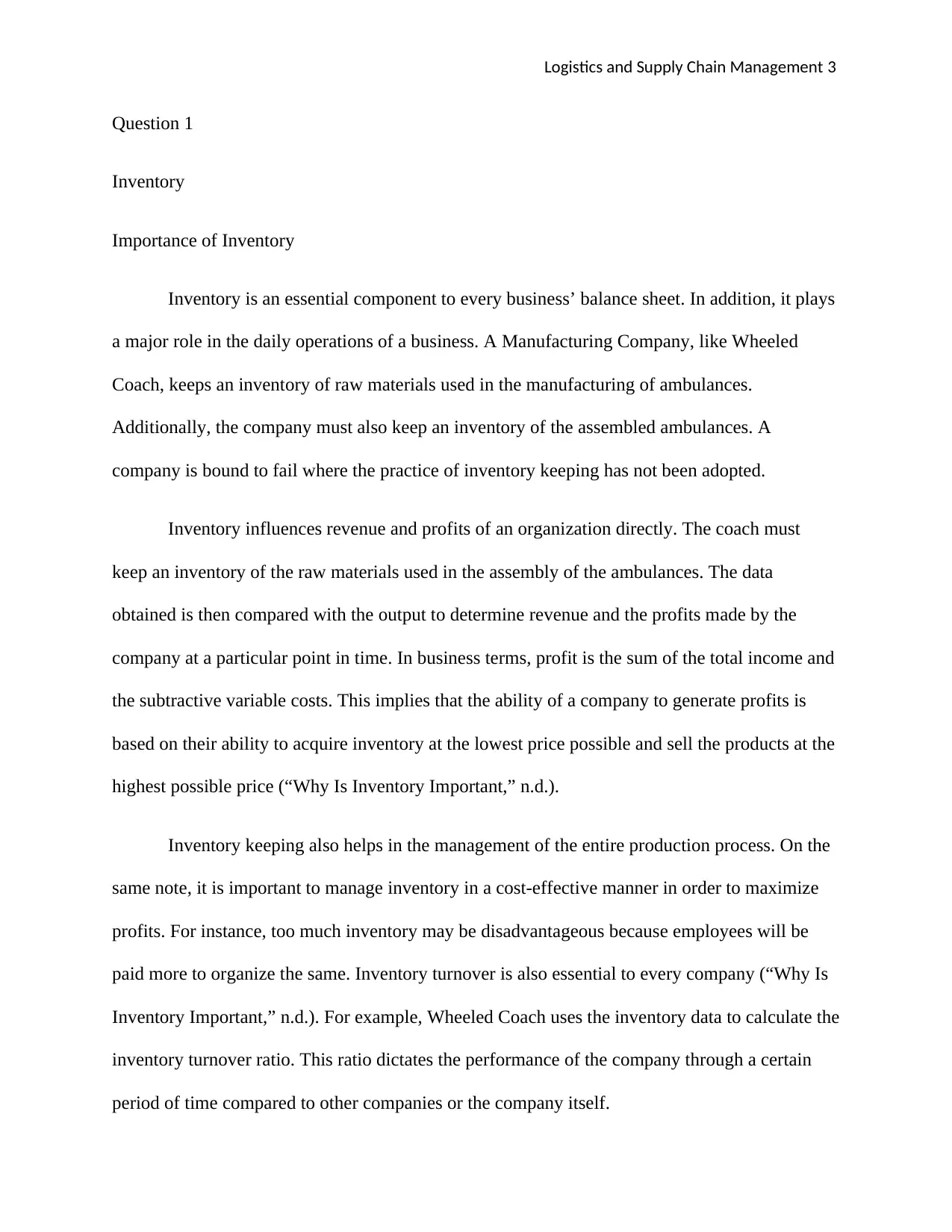
Logistics and Supply Chain Management 3
Question 1
Inventory
Importance of Inventory
Inventory is an essential component to every business’ balance sheet. In addition, it plays
a major role in the daily operations of a business. A Manufacturing Company, like Wheeled
Coach, keeps an inventory of raw materials used in the manufacturing of ambulances.
Additionally, the company must also keep an inventory of the assembled ambulances. A
company is bound to fail where the practice of inventory keeping has not been adopted.
Inventory influences revenue and profits of an organization directly. The coach must
keep an inventory of the raw materials used in the assembly of the ambulances. The data
obtained is then compared with the output to determine revenue and the profits made by the
company at a particular point in time. In business terms, profit is the sum of the total income and
the subtractive variable costs. This implies that the ability of a company to generate profits is
based on their ability to acquire inventory at the lowest price possible and sell the products at the
highest possible price (“Why Is Inventory Important,” n.d.).
Inventory keeping also helps in the management of the entire production process. On the
same note, it is important to manage inventory in a cost-effective manner in order to maximize
profits. For instance, too much inventory may be disadvantageous because employees will be
paid more to organize the same. Inventory turnover is also essential to every company (“Why Is
Inventory Important,” n.d.). For example, Wheeled Coach uses the inventory data to calculate the
inventory turnover ratio. This ratio dictates the performance of the company through a certain
period of time compared to other companies or the company itself.
Question 1
Inventory
Importance of Inventory
Inventory is an essential component to every business’ balance sheet. In addition, it plays
a major role in the daily operations of a business. A Manufacturing Company, like Wheeled
Coach, keeps an inventory of raw materials used in the manufacturing of ambulances.
Additionally, the company must also keep an inventory of the assembled ambulances. A
company is bound to fail where the practice of inventory keeping has not been adopted.
Inventory influences revenue and profits of an organization directly. The coach must
keep an inventory of the raw materials used in the assembly of the ambulances. The data
obtained is then compared with the output to determine revenue and the profits made by the
company at a particular point in time. In business terms, profit is the sum of the total income and
the subtractive variable costs. This implies that the ability of a company to generate profits is
based on their ability to acquire inventory at the lowest price possible and sell the products at the
highest possible price (“Why Is Inventory Important,” n.d.).
Inventory keeping also helps in the management of the entire production process. On the
same note, it is important to manage inventory in a cost-effective manner in order to maximize
profits. For instance, too much inventory may be disadvantageous because employees will be
paid more to organize the same. Inventory turnover is also essential to every company (“Why Is
Inventory Important,” n.d.). For example, Wheeled Coach uses the inventory data to calculate the
inventory turnover ratio. This ratio dictates the performance of the company through a certain
period of time compared to other companies or the company itself.
⊘ This is a preview!⊘
Do you want full access?
Subscribe today to unlock all pages.

Trusted by 1+ million students worldwide
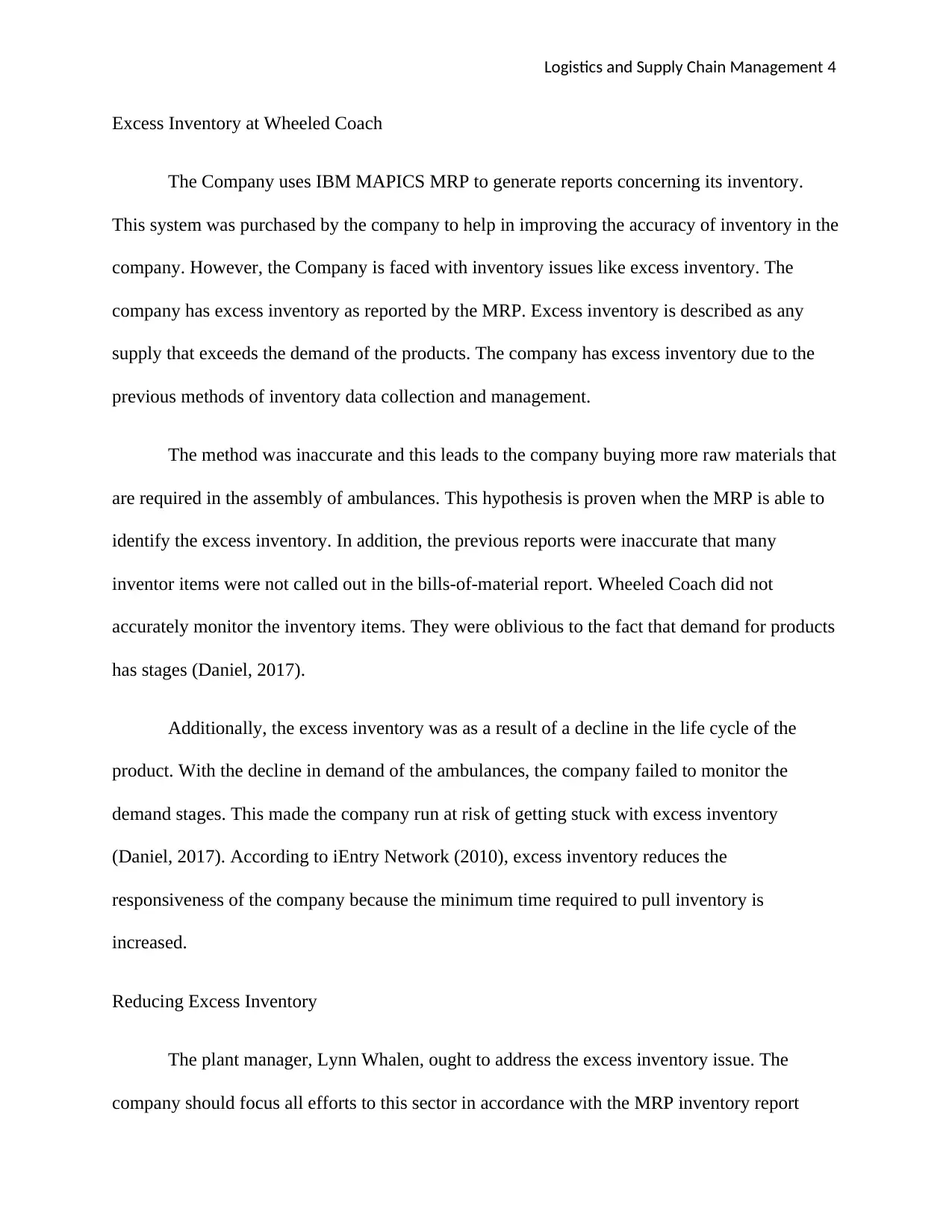
Logistics and Supply Chain Management 4
Excess Inventory at Wheeled Coach
The Company uses IBM MAPICS MRP to generate reports concerning its inventory.
This system was purchased by the company to help in improving the accuracy of inventory in the
company. However, the Company is faced with inventory issues like excess inventory. The
company has excess inventory as reported by the MRP. Excess inventory is described as any
supply that exceeds the demand of the products. The company has excess inventory due to the
previous methods of inventory data collection and management.
The method was inaccurate and this leads to the company buying more raw materials that
are required in the assembly of ambulances. This hypothesis is proven when the MRP is able to
identify the excess inventory. In addition, the previous reports were inaccurate that many
inventor items were not called out in the bills-of-material report. Wheeled Coach did not
accurately monitor the inventory items. They were oblivious to the fact that demand for products
has stages (Daniel, 2017).
Additionally, the excess inventory was as a result of a decline in the life cycle of the
product. With the decline in demand of the ambulances, the company failed to monitor the
demand stages. This made the company run at risk of getting stuck with excess inventory
(Daniel, 2017). According to iEntry Network (2010), excess inventory reduces the
responsiveness of the company because the minimum time required to pull inventory is
increased.
Reducing Excess Inventory
The plant manager, Lynn Whalen, ought to address the excess inventory issue. The
company should focus all efforts to this sector in accordance with the MRP inventory report
Excess Inventory at Wheeled Coach
The Company uses IBM MAPICS MRP to generate reports concerning its inventory.
This system was purchased by the company to help in improving the accuracy of inventory in the
company. However, the Company is faced with inventory issues like excess inventory. The
company has excess inventory as reported by the MRP. Excess inventory is described as any
supply that exceeds the demand of the products. The company has excess inventory due to the
previous methods of inventory data collection and management.
The method was inaccurate and this leads to the company buying more raw materials that
are required in the assembly of ambulances. This hypothesis is proven when the MRP is able to
identify the excess inventory. In addition, the previous reports were inaccurate that many
inventor items were not called out in the bills-of-material report. Wheeled Coach did not
accurately monitor the inventory items. They were oblivious to the fact that demand for products
has stages (Daniel, 2017).
Additionally, the excess inventory was as a result of a decline in the life cycle of the
product. With the decline in demand of the ambulances, the company failed to monitor the
demand stages. This made the company run at risk of getting stuck with excess inventory
(Daniel, 2017). According to iEntry Network (2010), excess inventory reduces the
responsiveness of the company because the minimum time required to pull inventory is
increased.
Reducing Excess Inventory
The plant manager, Lynn Whalen, ought to address the excess inventory issue. The
company should focus all efforts to this sector in accordance with the MRP inventory report
Paraphrase This Document
Need a fresh take? Get an instant paraphrase of this document with our AI Paraphraser
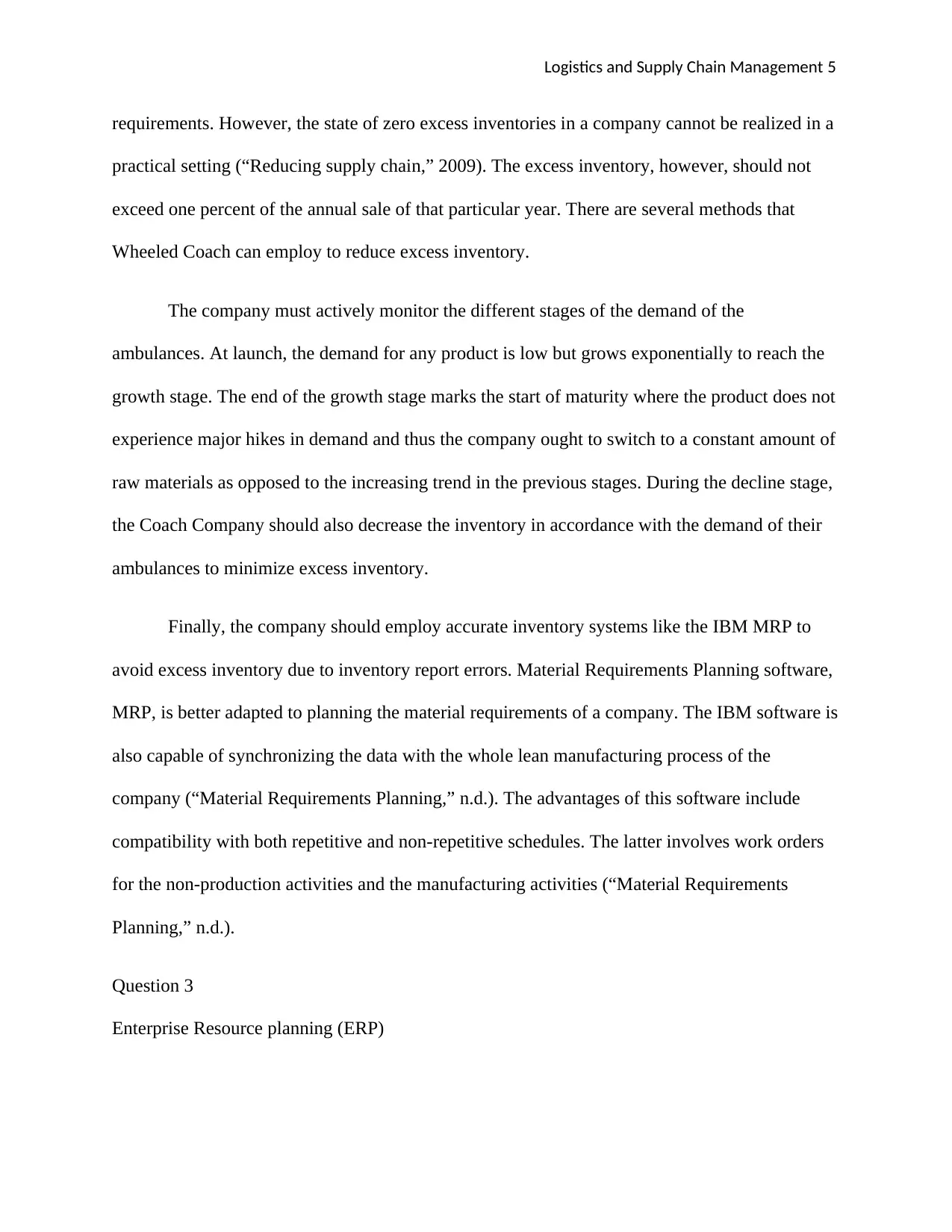
Logistics and Supply Chain Management 5
requirements. However, the state of zero excess inventories in a company cannot be realized in a
practical setting (“Reducing supply chain,” 2009). The excess inventory, however, should not
exceed one percent of the annual sale of that particular year. There are several methods that
Wheeled Coach can employ to reduce excess inventory.
The company must actively monitor the different stages of the demand of the
ambulances. At launch, the demand for any product is low but grows exponentially to reach the
growth stage. The end of the growth stage marks the start of maturity where the product does not
experience major hikes in demand and thus the company ought to switch to a constant amount of
raw materials as opposed to the increasing trend in the previous stages. During the decline stage,
the Coach Company should also decrease the inventory in accordance with the demand of their
ambulances to minimize excess inventory.
Finally, the company should employ accurate inventory systems like the IBM MRP to
avoid excess inventory due to inventory report errors. Material Requirements Planning software,
MRP, is better adapted to planning the material requirements of a company. The IBM software is
also capable of synchronizing the data with the whole lean manufacturing process of the
company (“Material Requirements Planning,” n.d.). The advantages of this software include
compatibility with both repetitive and non-repetitive schedules. The latter involves work orders
for the non-production activities and the manufacturing activities (“Material Requirements
Planning,” n.d.).
Question 3
Enterprise Resource planning (ERP)
requirements. However, the state of zero excess inventories in a company cannot be realized in a
practical setting (“Reducing supply chain,” 2009). The excess inventory, however, should not
exceed one percent of the annual sale of that particular year. There are several methods that
Wheeled Coach can employ to reduce excess inventory.
The company must actively monitor the different stages of the demand of the
ambulances. At launch, the demand for any product is low but grows exponentially to reach the
growth stage. The end of the growth stage marks the start of maturity where the product does not
experience major hikes in demand and thus the company ought to switch to a constant amount of
raw materials as opposed to the increasing trend in the previous stages. During the decline stage,
the Coach Company should also decrease the inventory in accordance with the demand of their
ambulances to minimize excess inventory.
Finally, the company should employ accurate inventory systems like the IBM MRP to
avoid excess inventory due to inventory report errors. Material Requirements Planning software,
MRP, is better adapted to planning the material requirements of a company. The IBM software is
also capable of synchronizing the data with the whole lean manufacturing process of the
company (“Material Requirements Planning,” n.d.). The advantages of this software include
compatibility with both repetitive and non-repetitive schedules. The latter involves work orders
for the non-production activities and the manufacturing activities (“Material Requirements
Planning,” n.d.).
Question 3
Enterprise Resource planning (ERP)
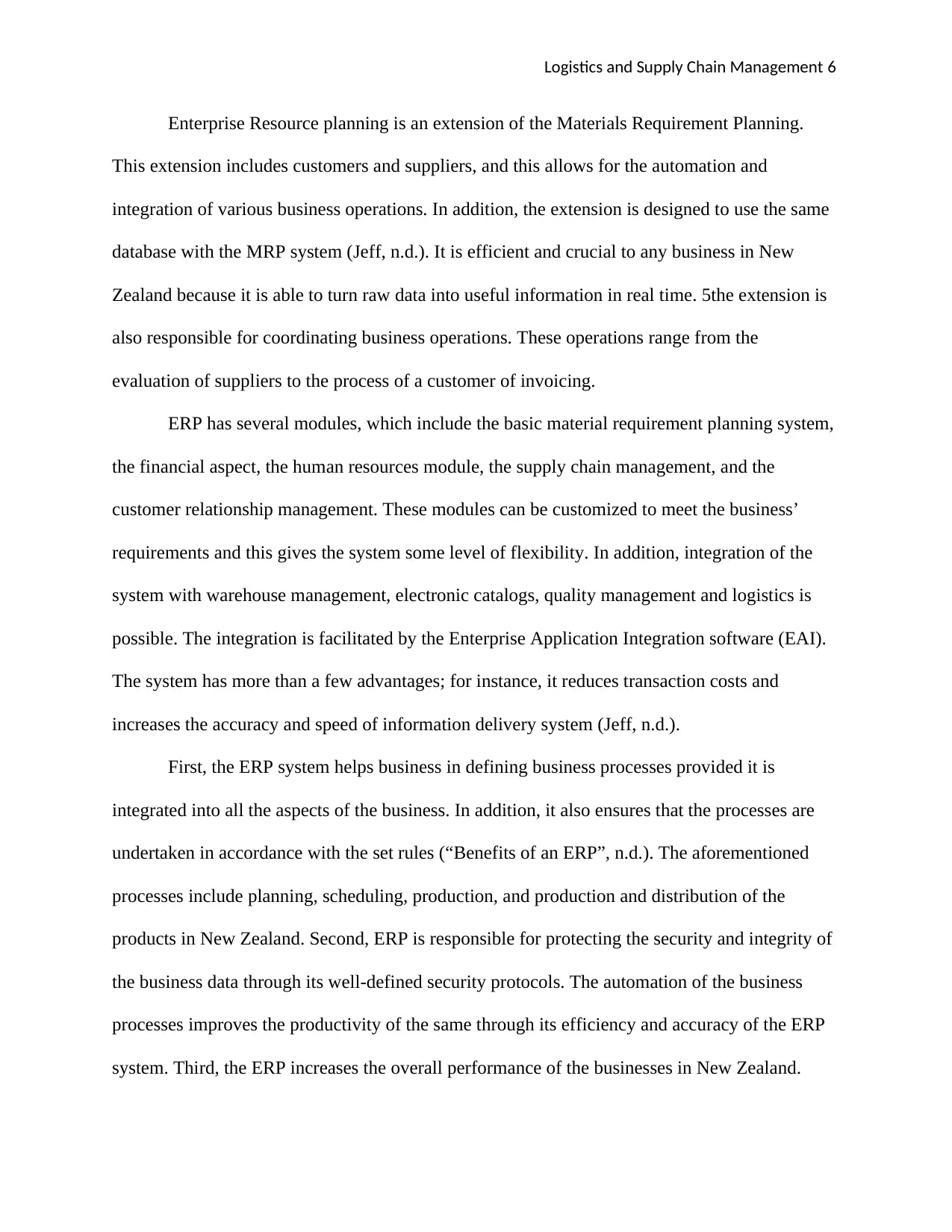
Logistics and Supply Chain Management 6
Enterprise Resource planning is an extension of the Materials Requirement Planning.
This extension includes customers and suppliers, and this allows for the automation and
integration of various business operations. In addition, the extension is designed to use the same
database with the MRP system (Jeff, n.d.). It is efficient and crucial to any business in New
Zealand because it is able to turn raw data into useful information in real time. 5the extension is
also responsible for coordinating business operations. These operations range from the
evaluation of suppliers to the process of a customer of invoicing.
ERP has several modules, which include the basic material requirement planning system,
the financial aspect, the human resources module, the supply chain management, and the
customer relationship management. These modules can be customized to meet the business’
requirements and this gives the system some level of flexibility. In addition, integration of the
system with warehouse management, electronic catalogs, quality management and logistics is
possible. The integration is facilitated by the Enterprise Application Integration software (EAI).
The system has more than a few advantages; for instance, it reduces transaction costs and
increases the accuracy and speed of information delivery system (Jeff, n.d.).
First, the ERP system helps business in defining business processes provided it is
integrated into all the aspects of the business. In addition, it also ensures that the processes are
undertaken in accordance with the set rules (“Benefits of an ERP”, n.d.). The aforementioned
processes include planning, scheduling, production, and production and distribution of the
products in New Zealand. Second, ERP is responsible for protecting the security and integrity of
the business data through its well-defined security protocols. The automation of the business
processes improves the productivity of the same through its efficiency and accuracy of the ERP
system. Third, the ERP increases the overall performance of the businesses in New Zealand.
Enterprise Resource planning is an extension of the Materials Requirement Planning.
This extension includes customers and suppliers, and this allows for the automation and
integration of various business operations. In addition, the extension is designed to use the same
database with the MRP system (Jeff, n.d.). It is efficient and crucial to any business in New
Zealand because it is able to turn raw data into useful information in real time. 5the extension is
also responsible for coordinating business operations. These operations range from the
evaluation of suppliers to the process of a customer of invoicing.
ERP has several modules, which include the basic material requirement planning system,
the financial aspect, the human resources module, the supply chain management, and the
customer relationship management. These modules can be customized to meet the business’
requirements and this gives the system some level of flexibility. In addition, integration of the
system with warehouse management, electronic catalogs, quality management and logistics is
possible. The integration is facilitated by the Enterprise Application Integration software (EAI).
The system has more than a few advantages; for instance, it reduces transaction costs and
increases the accuracy and speed of information delivery system (Jeff, n.d.).
First, the ERP system helps business in defining business processes provided it is
integrated into all the aspects of the business. In addition, it also ensures that the processes are
undertaken in accordance with the set rules (“Benefits of an ERP”, n.d.). The aforementioned
processes include planning, scheduling, production, and production and distribution of the
products in New Zealand. Second, ERP is responsible for protecting the security and integrity of
the business data through its well-defined security protocols. The automation of the business
processes improves the productivity of the same through its efficiency and accuracy of the ERP
system. Third, the ERP increases the overall performance of the businesses in New Zealand.
⊘ This is a preview!⊘
Do you want full access?
Subscribe today to unlock all pages.

Trusted by 1+ million students worldwide
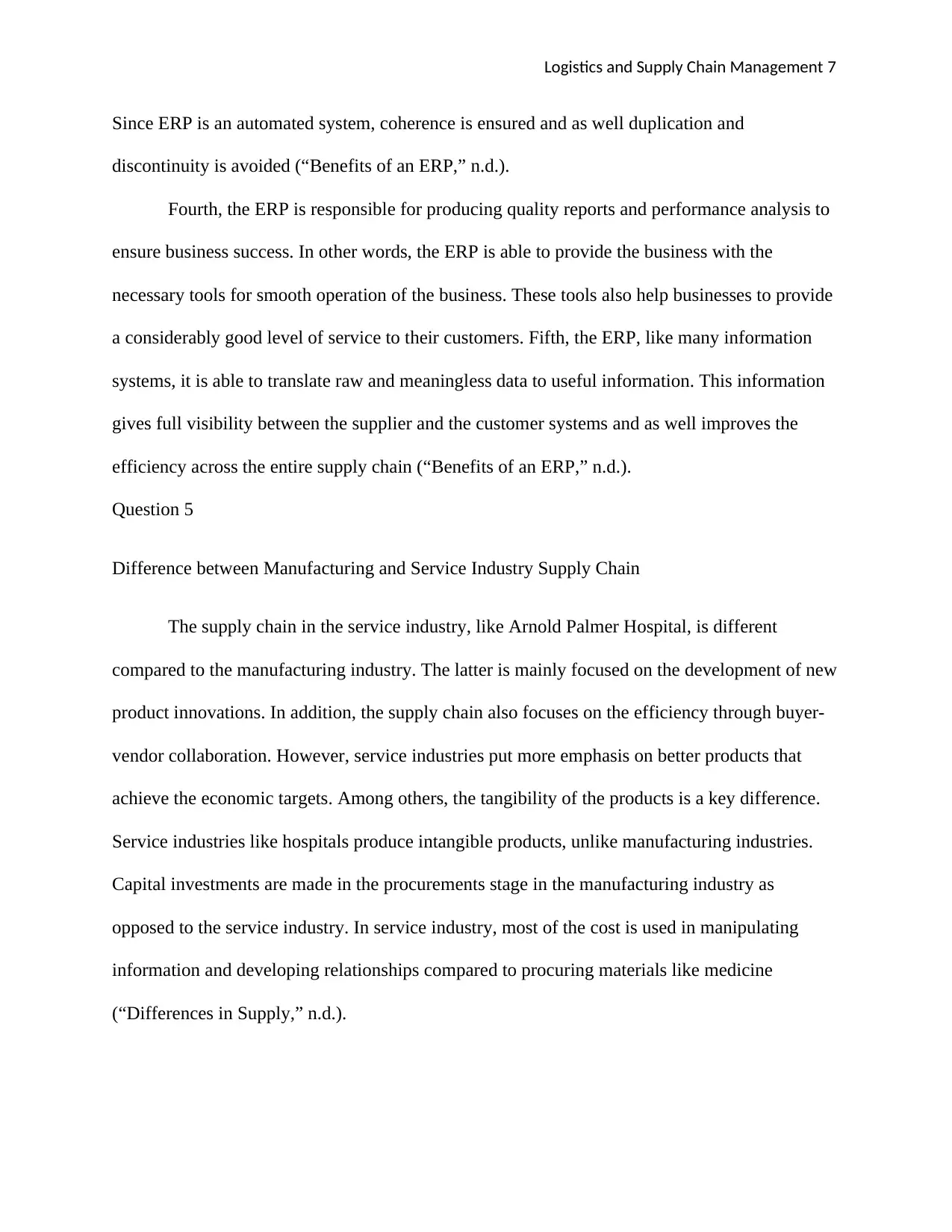
Logistics and Supply Chain Management 7
Since ERP is an automated system, coherence is ensured and as well duplication and
discontinuity is avoided (“Benefits of an ERP,” n.d.).
Fourth, the ERP is responsible for producing quality reports and performance analysis to
ensure business success. In other words, the ERP is able to provide the business with the
necessary tools for smooth operation of the business. These tools also help businesses to provide
a considerably good level of service to their customers. Fifth, the ERP, like many information
systems, it is able to translate raw and meaningless data to useful information. This information
gives full visibility between the supplier and the customer systems and as well improves the
efficiency across the entire supply chain (“Benefits of an ERP,” n.d.).
Question 5
Difference between Manufacturing and Service Industry Supply Chain
The supply chain in the service industry, like Arnold Palmer Hospital, is different
compared to the manufacturing industry. The latter is mainly focused on the development of new
product innovations. In addition, the supply chain also focuses on the efficiency through buyer-
vendor collaboration. However, service industries put more emphasis on better products that
achieve the economic targets. Among others, the tangibility of the products is a key difference.
Service industries like hospitals produce intangible products, unlike manufacturing industries.
Capital investments are made in the procurements stage in the manufacturing industry as
opposed to the service industry. In service industry, most of the cost is used in manipulating
information and developing relationships compared to procuring materials like medicine
(“Differences in Supply,” n.d.).
Since ERP is an automated system, coherence is ensured and as well duplication and
discontinuity is avoided (“Benefits of an ERP,” n.d.).
Fourth, the ERP is responsible for producing quality reports and performance analysis to
ensure business success. In other words, the ERP is able to provide the business with the
necessary tools for smooth operation of the business. These tools also help businesses to provide
a considerably good level of service to their customers. Fifth, the ERP, like many information
systems, it is able to translate raw and meaningless data to useful information. This information
gives full visibility between the supplier and the customer systems and as well improves the
efficiency across the entire supply chain (“Benefits of an ERP,” n.d.).
Question 5
Difference between Manufacturing and Service Industry Supply Chain
The supply chain in the service industry, like Arnold Palmer Hospital, is different
compared to the manufacturing industry. The latter is mainly focused on the development of new
product innovations. In addition, the supply chain also focuses on the efficiency through buyer-
vendor collaboration. However, service industries put more emphasis on better products that
achieve the economic targets. Among others, the tangibility of the products is a key difference.
Service industries like hospitals produce intangible products, unlike manufacturing industries.
Capital investments are made in the procurements stage in the manufacturing industry as
opposed to the service industry. In service industry, most of the cost is used in manipulating
information and developing relationships compared to procuring materials like medicine
(“Differences in Supply,” n.d.).
Paraphrase This Document
Need a fresh take? Get an instant paraphrase of this document with our AI Paraphraser
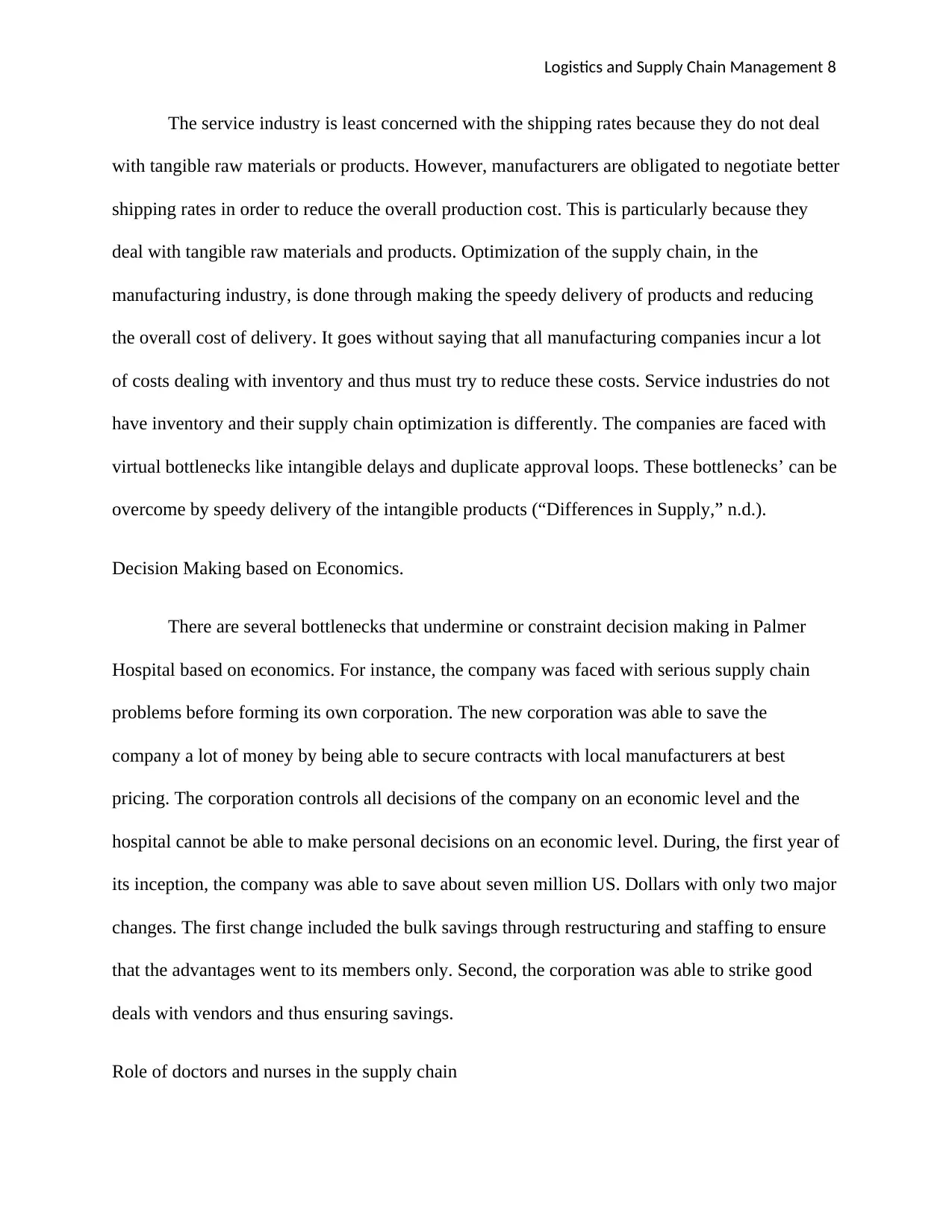
Logistics and Supply Chain Management 8
The service industry is least concerned with the shipping rates because they do not deal
with tangible raw materials or products. However, manufacturers are obligated to negotiate better
shipping rates in order to reduce the overall production cost. This is particularly because they
deal with tangible raw materials and products. Optimization of the supply chain, in the
manufacturing industry, is done through making the speedy delivery of products and reducing
the overall cost of delivery. It goes without saying that all manufacturing companies incur a lot
of costs dealing with inventory and thus must try to reduce these costs. Service industries do not
have inventory and their supply chain optimization is differently. The companies are faced with
virtual bottlenecks like intangible delays and duplicate approval loops. These bottlenecks’ can be
overcome by speedy delivery of the intangible products (“Differences in Supply,” n.d.).
Decision Making based on Economics.
There are several bottlenecks that undermine or constraint decision making in Palmer
Hospital based on economics. For instance, the company was faced with serious supply chain
problems before forming its own corporation. The new corporation was able to save the
company a lot of money by being able to secure contracts with local manufacturers at best
pricing. The corporation controls all decisions of the company on an economic level and the
hospital cannot be able to make personal decisions on an economic level. During, the first year of
its inception, the company was able to save about seven million US. Dollars with only two major
changes. The first change included the bulk savings through restructuring and staffing to ensure
that the advantages went to its members only. Second, the corporation was able to strike good
deals with vendors and thus ensuring savings.
Role of doctors and nurses in the supply chain
The service industry is least concerned with the shipping rates because they do not deal
with tangible raw materials or products. However, manufacturers are obligated to negotiate better
shipping rates in order to reduce the overall production cost. This is particularly because they
deal with tangible raw materials and products. Optimization of the supply chain, in the
manufacturing industry, is done through making the speedy delivery of products and reducing
the overall cost of delivery. It goes without saying that all manufacturing companies incur a lot
of costs dealing with inventory and thus must try to reduce these costs. Service industries do not
have inventory and their supply chain optimization is differently. The companies are faced with
virtual bottlenecks like intangible delays and duplicate approval loops. These bottlenecks’ can be
overcome by speedy delivery of the intangible products (“Differences in Supply,” n.d.).
Decision Making based on Economics.
There are several bottlenecks that undermine or constraint decision making in Palmer
Hospital based on economics. For instance, the company was faced with serious supply chain
problems before forming its own corporation. The new corporation was able to save the
company a lot of money by being able to secure contracts with local manufacturers at best
pricing. The corporation controls all decisions of the company on an economic level and the
hospital cannot be able to make personal decisions on an economic level. During, the first year of
its inception, the company was able to save about seven million US. Dollars with only two major
changes. The first change included the bulk savings through restructuring and staffing to ensure
that the advantages went to its members only. Second, the corporation was able to strike good
deals with vendors and thus ensuring savings.
Role of doctors and nurses in the supply chain
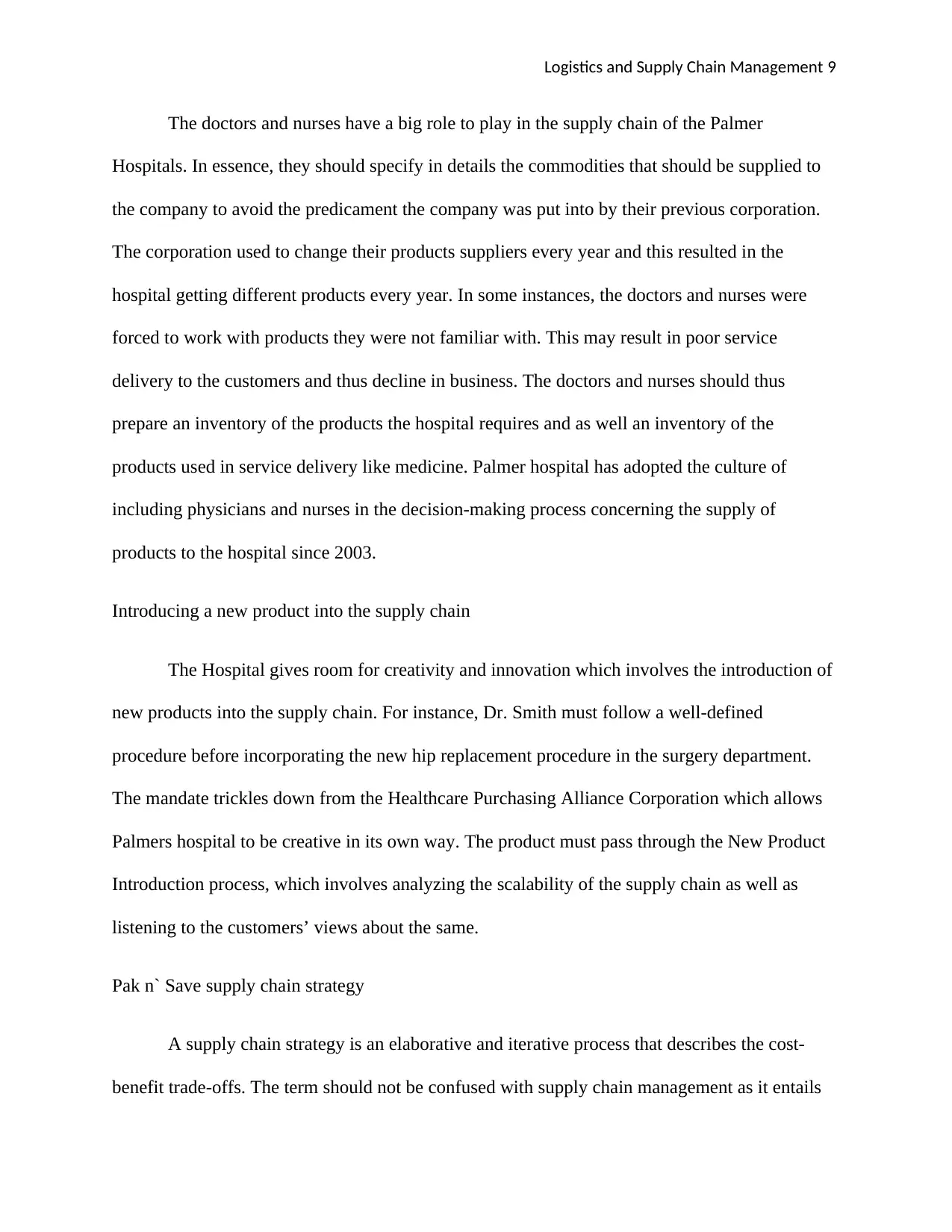
Logistics and Supply Chain Management 9
The doctors and nurses have a big role to play in the supply chain of the Palmer
Hospitals. In essence, they should specify in details the commodities that should be supplied to
the company to avoid the predicament the company was put into by their previous corporation.
The corporation used to change their products suppliers every year and this resulted in the
hospital getting different products every year. In some instances, the doctors and nurses were
forced to work with products they were not familiar with. This may result in poor service
delivery to the customers and thus decline in business. The doctors and nurses should thus
prepare an inventory of the products the hospital requires and as well an inventory of the
products used in service delivery like medicine. Palmer hospital has adopted the culture of
including physicians and nurses in the decision-making process concerning the supply of
products to the hospital since 2003.
Introducing a new product into the supply chain
The Hospital gives room for creativity and innovation which involves the introduction of
new products into the supply chain. For instance, Dr. Smith must follow a well-defined
procedure before incorporating the new hip replacement procedure in the surgery department.
The mandate trickles down from the Healthcare Purchasing Alliance Corporation which allows
Palmers hospital to be creative in its own way. The product must pass through the New Product
Introduction process, which involves analyzing the scalability of the supply chain as well as
listening to the customers’ views about the same.
Pak n` Save supply chain strategy
A supply chain strategy is an elaborative and iterative process that describes the cost-
benefit trade-offs. The term should not be confused with supply chain management as it entails
The doctors and nurses have a big role to play in the supply chain of the Palmer
Hospitals. In essence, they should specify in details the commodities that should be supplied to
the company to avoid the predicament the company was put into by their previous corporation.
The corporation used to change their products suppliers every year and this resulted in the
hospital getting different products every year. In some instances, the doctors and nurses were
forced to work with products they were not familiar with. This may result in poor service
delivery to the customers and thus decline in business. The doctors and nurses should thus
prepare an inventory of the products the hospital requires and as well an inventory of the
products used in service delivery like medicine. Palmer hospital has adopted the culture of
including physicians and nurses in the decision-making process concerning the supply of
products to the hospital since 2003.
Introducing a new product into the supply chain
The Hospital gives room for creativity and innovation which involves the introduction of
new products into the supply chain. For instance, Dr. Smith must follow a well-defined
procedure before incorporating the new hip replacement procedure in the surgery department.
The mandate trickles down from the Healthcare Purchasing Alliance Corporation which allows
Palmers hospital to be creative in its own way. The product must pass through the New Product
Introduction process, which involves analyzing the scalability of the supply chain as well as
listening to the customers’ views about the same.
Pak n` Save supply chain strategy
A supply chain strategy is an elaborative and iterative process that describes the cost-
benefit trade-offs. The term should not be confused with supply chain management as it entails
⊘ This is a preview!⊘
Do you want full access?
Subscribe today to unlock all pages.

Trusted by 1+ million students worldwide
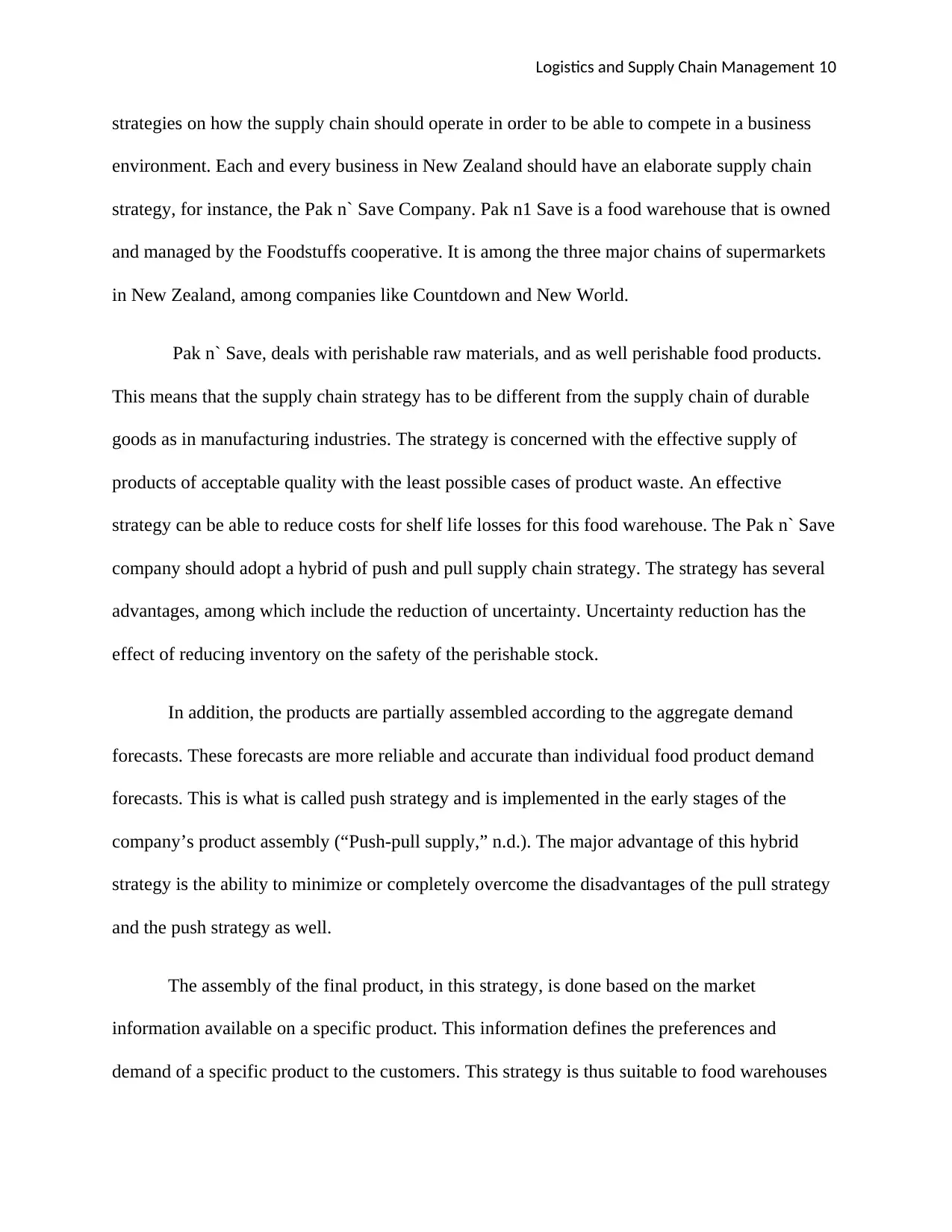
Logistics and Supply Chain Management 10
strategies on how the supply chain should operate in order to be able to compete in a business
environment. Each and every business in New Zealand should have an elaborate supply chain
strategy, for instance, the Pak n` Save Company. Pak n1 Save is a food warehouse that is owned
and managed by the Foodstuffs cooperative. It is among the three major chains of supermarkets
in New Zealand, among companies like Countdown and New World.
Pak n` Save, deals with perishable raw materials, and as well perishable food products.
This means that the supply chain strategy has to be different from the supply chain of durable
goods as in manufacturing industries. The strategy is concerned with the effective supply of
products of acceptable quality with the least possible cases of product waste. An effective
strategy can be able to reduce costs for shelf life losses for this food warehouse. The Pak n` Save
company should adopt a hybrid of push and pull supply chain strategy. The strategy has several
advantages, among which include the reduction of uncertainty. Uncertainty reduction has the
effect of reducing inventory on the safety of the perishable stock.
In addition, the products are partially assembled according to the aggregate demand
forecasts. These forecasts are more reliable and accurate than individual food product demand
forecasts. This is what is called push strategy and is implemented in the early stages of the
company’s product assembly (“Push-pull supply,” n.d.). The major advantage of this hybrid
strategy is the ability to minimize or completely overcome the disadvantages of the pull strategy
and the push strategy as well.
The assembly of the final product, in this strategy, is done based on the market
information available on a specific product. This information defines the preferences and
demand of a specific product to the customers. This strategy is thus suitable to food warehouses
strategies on how the supply chain should operate in order to be able to compete in a business
environment. Each and every business in New Zealand should have an elaborate supply chain
strategy, for instance, the Pak n` Save Company. Pak n1 Save is a food warehouse that is owned
and managed by the Foodstuffs cooperative. It is among the three major chains of supermarkets
in New Zealand, among companies like Countdown and New World.
Pak n` Save, deals with perishable raw materials, and as well perishable food products.
This means that the supply chain strategy has to be different from the supply chain of durable
goods as in manufacturing industries. The strategy is concerned with the effective supply of
products of acceptable quality with the least possible cases of product waste. An effective
strategy can be able to reduce costs for shelf life losses for this food warehouse. The Pak n` Save
company should adopt a hybrid of push and pull supply chain strategy. The strategy has several
advantages, among which include the reduction of uncertainty. Uncertainty reduction has the
effect of reducing inventory on the safety of the perishable stock.
In addition, the products are partially assembled according to the aggregate demand
forecasts. These forecasts are more reliable and accurate than individual food product demand
forecasts. This is what is called push strategy and is implemented in the early stages of the
company’s product assembly (“Push-pull supply,” n.d.). The major advantage of this hybrid
strategy is the ability to minimize or completely overcome the disadvantages of the pull strategy
and the push strategy as well.
The assembly of the final product, in this strategy, is done based on the market
information available on a specific product. This information defines the preferences and
demand of a specific product to the customers. This strategy is thus suitable to food warehouses
Paraphrase This Document
Need a fresh take? Get an instant paraphrase of this document with our AI Paraphraser
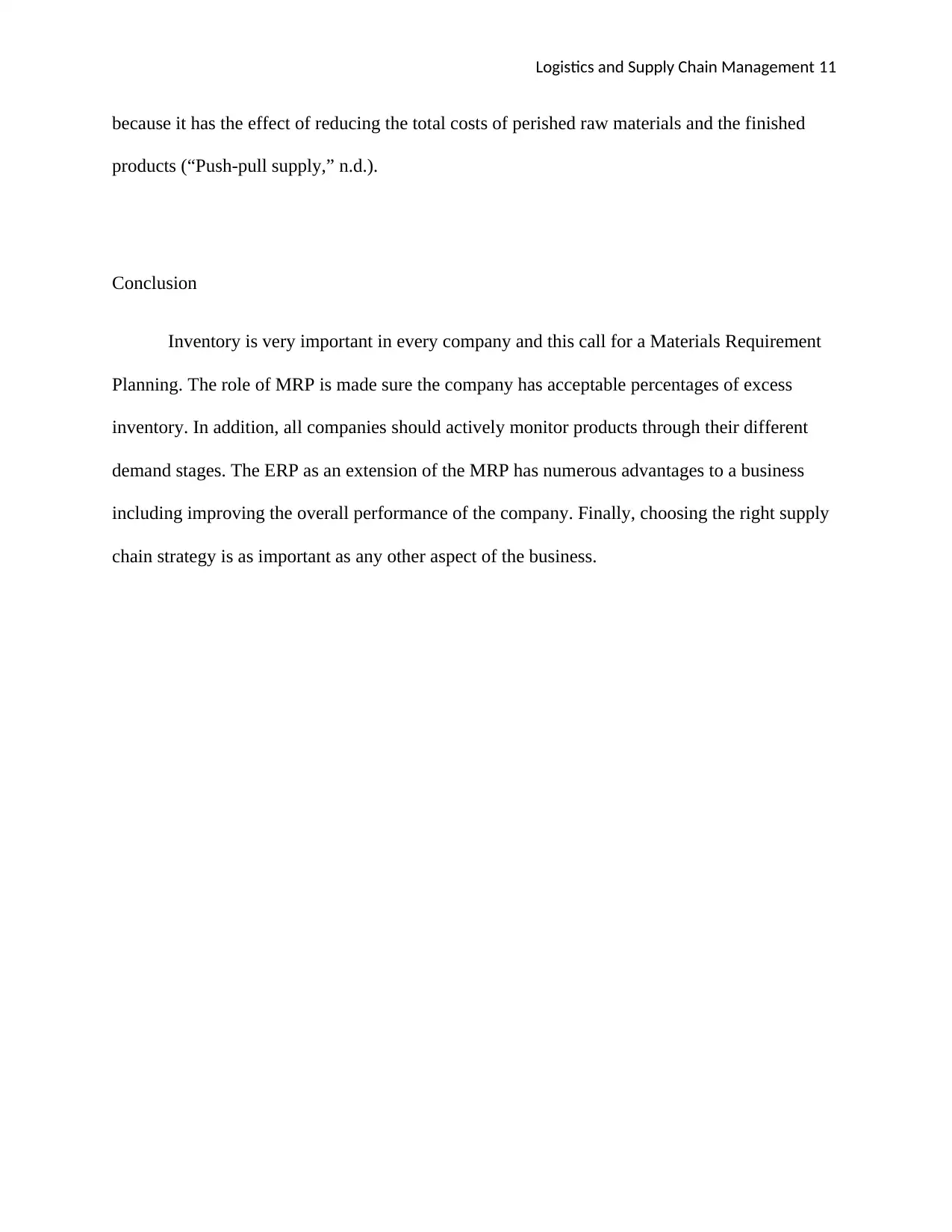
Logistics and Supply Chain Management 11
because it has the effect of reducing the total costs of perished raw materials and the finished
products (“Push-pull supply,” n.d.).
Conclusion
Inventory is very important in every company and this call for a Materials Requirement
Planning. The role of MRP is made sure the company has acceptable percentages of excess
inventory. In addition, all companies should actively monitor products through their different
demand stages. The ERP as an extension of the MRP has numerous advantages to a business
including improving the overall performance of the company. Finally, choosing the right supply
chain strategy is as important as any other aspect of the business.
because it has the effect of reducing the total costs of perished raw materials and the finished
products (“Push-pull supply,” n.d.).
Conclusion
Inventory is very important in every company and this call for a Materials Requirement
Planning. The role of MRP is made sure the company has acceptable percentages of excess
inventory. In addition, all companies should actively monitor products through their different
demand stages. The ERP as an extension of the MRP has numerous advantages to a business
including improving the overall performance of the company. Finally, choosing the right supply
chain strategy is as important as any other aspect of the business.
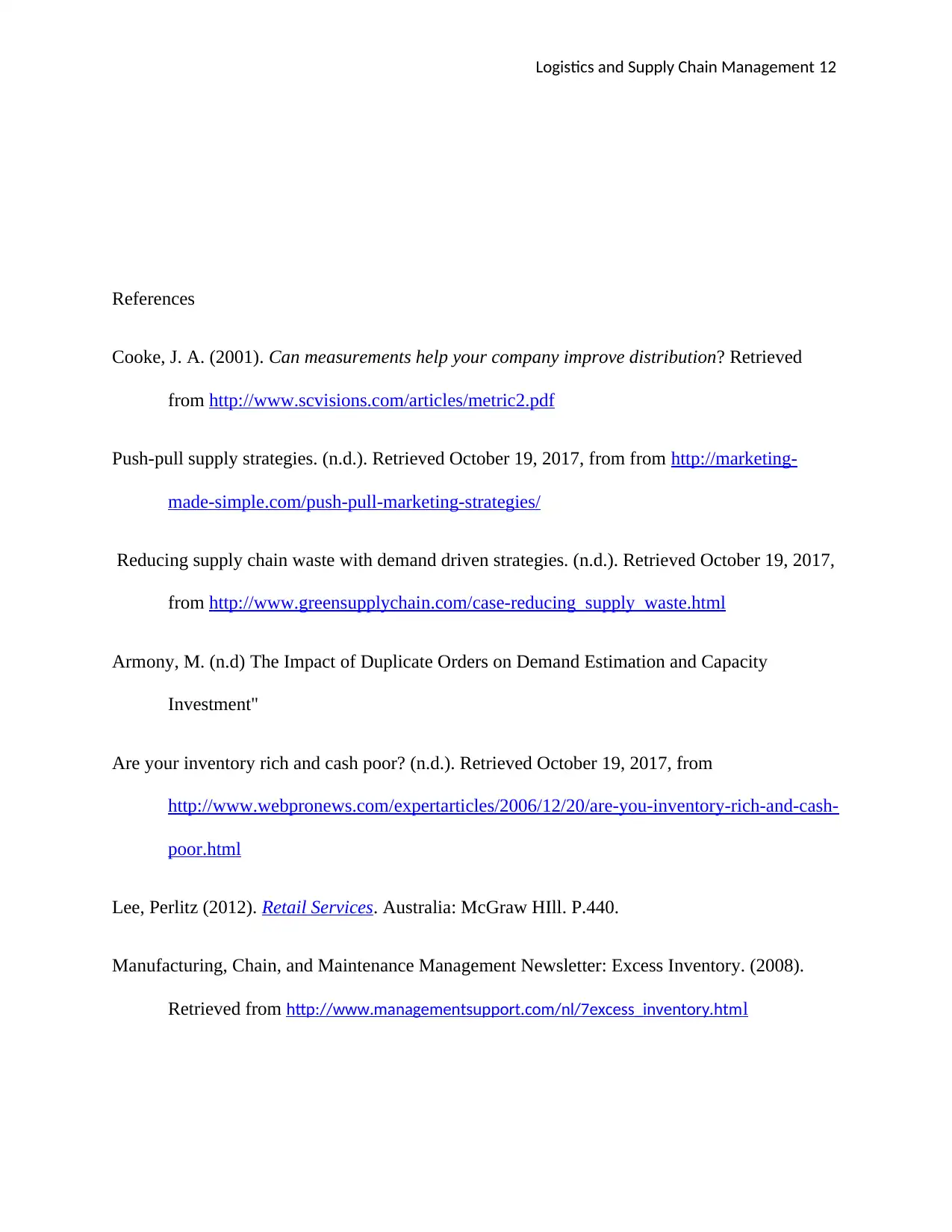
Logistics and Supply Chain Management 12
References
Cooke, J. A. (2001). Can measurements help your company improve distribution? Retrieved
from http://www.scvisions.com/articles/metric2.pdf
Push-pull supply strategies. (n.d.). Retrieved October 19, 2017, from from http://marketing-
made-simple.com/push-pull-marketing-strategies/
Reducing supply chain waste with demand driven strategies. (n.d.). Retrieved October 19, 2017,
from http://www.greensupplychain.com/case-reducing_supply_waste.html
Armony, M. (n.d) The Impact of Duplicate Orders on Demand Estimation and Capacity
Investment"
Are your inventory rich and cash poor? (n.d.). Retrieved October 19, 2017, from
http://www.webpronews.com/expertarticles/2006/12/20/are-you-inventory-rich-and-cash-
poor.html
Lee, Perlitz (2012). Retail Services. Australia: McGraw HIll. P.440.
Manufacturing, Chain, and Maintenance Management Newsletter: Excess Inventory. (2008).
Retrieved from http://www.managementsupport.com/nl/7excess_inventory.html
References
Cooke, J. A. (2001). Can measurements help your company improve distribution? Retrieved
from http://www.scvisions.com/articles/metric2.pdf
Push-pull supply strategies. (n.d.). Retrieved October 19, 2017, from from http://marketing-
made-simple.com/push-pull-marketing-strategies/
Reducing supply chain waste with demand driven strategies. (n.d.). Retrieved October 19, 2017,
from http://www.greensupplychain.com/case-reducing_supply_waste.html
Armony, M. (n.d) The Impact of Duplicate Orders on Demand Estimation and Capacity
Investment"
Are your inventory rich and cash poor? (n.d.). Retrieved October 19, 2017, from
http://www.webpronews.com/expertarticles/2006/12/20/are-you-inventory-rich-and-cash-
poor.html
Lee, Perlitz (2012). Retail Services. Australia: McGraw HIll. P.440.
Manufacturing, Chain, and Maintenance Management Newsletter: Excess Inventory. (2008).
Retrieved from http://www.managementsupport.com/nl/7excess_inventory.html
⊘ This is a preview!⊘
Do you want full access?
Subscribe today to unlock all pages.

Trusted by 1+ million students worldwide
1 out of 15
Related Documents
Your All-in-One AI-Powered Toolkit for Academic Success.
+13062052269
info@desklib.com
Available 24*7 on WhatsApp / Email
![[object Object]](/_next/static/media/star-bottom.7253800d.svg)
Unlock your academic potential
Copyright © 2020–2025 A2Z Services. All Rights Reserved. Developed and managed by ZUCOL.





